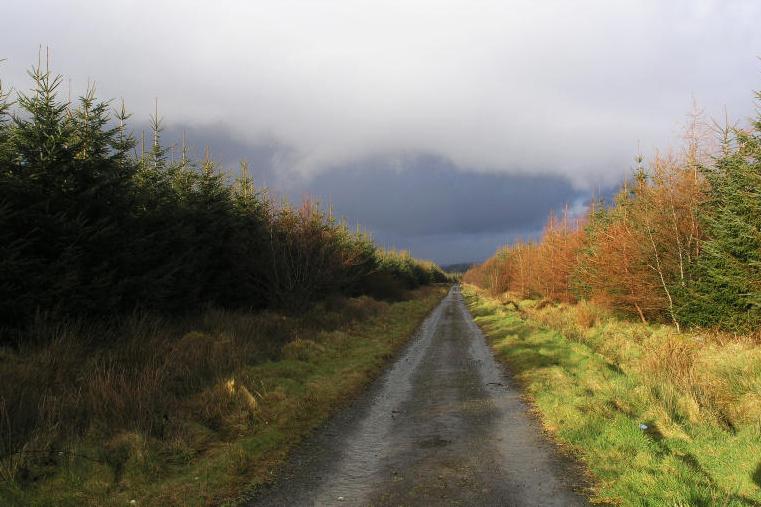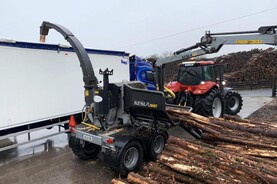Wood mobilisation, the sustainable harvesting and supply of timber from the forest to processors and end users, is recognised as one of most significant challenges for the sector. Wood and biomass mobilisation is one of the key topics to be addressed at the Energy in Agriculture event in Gurteen Agricultural College in Tipperary on 22 August.
Irish forests provide a rapidly growing source of renewable raw materials for use as wood fuels and in the production of a range of wood products. The potential for added-value products in the bio-economy is also rapidly developing. The emerging challenge is how to sustainably increase the harvest of wood to satisfy growing consumer and processor needs.
Timber output to double
It is estimated that timber output will double 8m cubic metres over the next two decades. This production will mainly come from farm forestry which has been supported by grants and premiums from the Forest Service. The doubling of volume output must be achieved through best forest management and timely thinning of suitable forests to ensure a regular timber and biomass supply to appropriate markets.
This mobilisation of our forest resource will optimise benefits along the supply chain from forest owners through to end users. Farm forest owners can greatly help to optimise the potential of their forests by working in co-operation with other owners, assessing the progress of their timber crop time, preparing for thinning and timber marketing in good time and ensuring that harvesting and extraction is carried out in appropriate locations and in an efficient and environmentally sustainable manner.
Coordination among forest owners
The supply of wood biomass requires well-planned and efficient linkages to be developed along the supply chain. There are almost 20,000 private forest owners in Ireland. The average size of these forests is 8ha. Fragmentation of plantations can pose a significant challenge in terms of access and costs.
However, there are major benefits in forest owners working together. Over the past decade, a range of forest owner groups have evolved around Ireland. A forest owner group can help achieve economies of scale by providing well coordinated and shared services.
The Forest Service is addressing the mobilisation of timber in a range of ways, including supporting of pilot Knowledge Transfer Groups currently based in Limerick/Tipperary, Donegal and Clare.
Road access
The timely planning of future access and construction of forest roads or entrances are critical activities which can also increase the value of forest plantations. The standard width of clearance for roads within the forest is 15m. Road construction should be carried out by competent and experienced contractors. Roads should be constructed well in advance of use and allowed settle to ensure optimum performance.
Road maintenance is also vital with keeping the road in good working order. All forest roads will experience wear and tear, especially during timber harvesting and follow up timely repairs are recommended.
Haulage
Haulage is a vital link in the timber and biomass supply chain. Approximately 65% of all forests are located on Grade 4 roads. Wood biomass must be delivered to the end user or energy plant at the lowest cost possible to be competitive. Optimum routes need to be planned in advance, taking into consideration the requirements of regulatory authorities.
Opportunities in the bioeconomy
AgriForValor is an EU Horizon 2020-funded project with a focus on bringing added value to the agriculture and forestry sectors. Ireland partners include the Institute of Technology Tralee (Irish hub manager), the Irish Farmers Association, the Irish Forest and Forest Products Association (IBEC) and Teagasc.
There are three main sources of raw material for wood energy in the Republic Of Ireland. These include small roundwood (pulpwood or energy wood from thinnings), wood residues from the processing sector and post-consumer recovered wood. There is also the potential to achieve additional biomass through harvesting of tree tips (from tip to 7cm diameter) and harvesting of tree branches and some harvest loss material (lop and top) on appropriate forest sites.
Based on a range of qualifying assumptions, the volume of wood fibre for energy, wood-based panels and other uses potentially available will increase from 1.8m cubic metres in 2016 to almost 4.2m cubic meters in 2035.
One of the innovation areas identified by AgriForValor is the concept of biomass logistic and trade centres. These centres link wood and biomass supply from forest owners, sawmills and other wood producers to the demand from small and larger buyers. Woody biomass products are marketed at standardised quality with a focus on domestic market uptake. The Agriforvalor project is co-ordinating an innovation partnership group to investigate the potential and develop templates for such biomass trade centres.
The Energy in Agriculture conference is taking place in Gurteen College, Co Tipperary, on 22 August from 10am to 5pm. The event is free and KT-approved. Register online to attend and book individual advice clinics. Read more
Special focus: renewable energy
Wood mobilisation, the sustainable harvesting and supply of timber from the forest to processors and end users, is recognised as one of most significant challenges for the sector. Wood and biomass mobilisation is one of the key topics to be addressed at the Energy in Agriculture event in Gurteen Agricultural College in Tipperary on 22 August.
Irish forests provide a rapidly growing source of renewable raw materials for use as wood fuels and in the production of a range of wood products. The potential for added-value products in the bio-economy is also rapidly developing. The emerging challenge is how to sustainably increase the harvest of wood to satisfy growing consumer and processor needs.
Timber output to double
It is estimated that timber output will double 8m cubic metres over the next two decades. This production will mainly come from farm forestry which has been supported by grants and premiums from the Forest Service. The doubling of volume output must be achieved through best forest management and timely thinning of suitable forests to ensure a regular timber and biomass supply to appropriate markets.
This mobilisation of our forest resource will optimise benefits along the supply chain from forest owners through to end users. Farm forest owners can greatly help to optimise the potential of their forests by working in co-operation with other owners, assessing the progress of their timber crop time, preparing for thinning and timber marketing in good time and ensuring that harvesting and extraction is carried out in appropriate locations and in an efficient and environmentally sustainable manner.
Coordination among forest owners
The supply of wood biomass requires well-planned and efficient linkages to be developed along the supply chain. There are almost 20,000 private forest owners in Ireland. The average size of these forests is 8ha. Fragmentation of plantations can pose a significant challenge in terms of access and costs.
However, there are major benefits in forest owners working together. Over the past decade, a range of forest owner groups have evolved around Ireland. A forest owner group can help achieve economies of scale by providing well coordinated and shared services.
The Forest Service is addressing the mobilisation of timber in a range of ways, including supporting of pilot Knowledge Transfer Groups currently based in Limerick/Tipperary, Donegal and Clare.
Road access
The timely planning of future access and construction of forest roads or entrances are critical activities which can also increase the value of forest plantations. The standard width of clearance for roads within the forest is 15m. Road construction should be carried out by competent and experienced contractors. Roads should be constructed well in advance of use and allowed settle to ensure optimum performance.
Road maintenance is also vital with keeping the road in good working order. All forest roads will experience wear and tear, especially during timber harvesting and follow up timely repairs are recommended.
Haulage
Haulage is a vital link in the timber and biomass supply chain. Approximately 65% of all forests are located on Grade 4 roads. Wood biomass must be delivered to the end user or energy plant at the lowest cost possible to be competitive. Optimum routes need to be planned in advance, taking into consideration the requirements of regulatory authorities.
Opportunities in the bioeconomy
AgriForValor is an EU Horizon 2020-funded project with a focus on bringing added value to the agriculture and forestry sectors. Ireland partners include the Institute of Technology Tralee (Irish hub manager), the Irish Farmers Association, the Irish Forest and Forest Products Association (IBEC) and Teagasc.
There are three main sources of raw material for wood energy in the Republic Of Ireland. These include small roundwood (pulpwood or energy wood from thinnings), wood residues from the processing sector and post-consumer recovered wood. There is also the potential to achieve additional biomass through harvesting of tree tips (from tip to 7cm diameter) and harvesting of tree branches and some harvest loss material (lop and top) on appropriate forest sites.
Based on a range of qualifying assumptions, the volume of wood fibre for energy, wood-based panels and other uses potentially available will increase from 1.8m cubic metres in 2016 to almost 4.2m cubic meters in 2035.
One of the innovation areas identified by AgriForValor is the concept of biomass logistic and trade centres. These centres link wood and biomass supply from forest owners, sawmills and other wood producers to the demand from small and larger buyers. Woody biomass products are marketed at standardised quality with a focus on domestic market uptake. The Agriforvalor project is co-ordinating an innovation partnership group to investigate the potential and develop templates for such biomass trade centres.
The Energy in Agriculture conference is taking place in Gurteen College, Co Tipperary, on 22 August from 10am to 5pm. The event is free and KT-approved. Register online to attend and book individual advice clinics. Read more
Special focus: renewable energy






 This is a subscriber-only article
This is a subscriber-only article










SHARING OPTIONS: